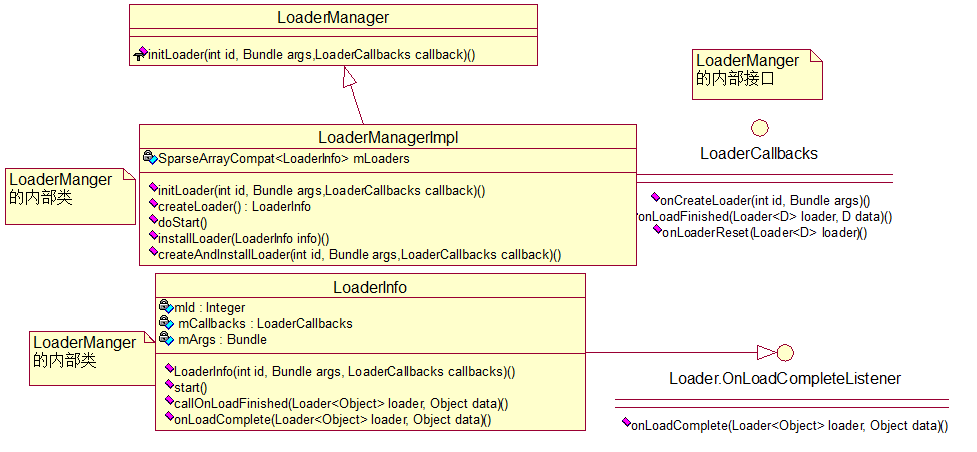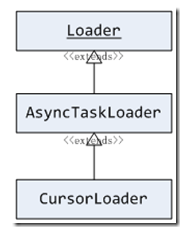黑马程序员Android之Loader理解
来源:互联网 发布:骑士cms二次开发手册 编辑:程序博客网 时间:2024/05/19 06:16
------- <a href="http://www.itheima.com" target="blank">android培训</a>、<a href="http://www.itheima.com" target="blank">java培训</a>、期待与您交流! ----------
在看Android的文档时,看到了这么一个东西: Loader
究竟是什么东西呢?
Introduced in Android 3.0, loaders make it easy to asynchronously load data in an activity or fragment. Loaders have these characteristics:
1、They are available to every Activity and Fragment. //支持Activity和Fragment
2、They provide asynchronous loading of data. //异步下载
3、They monitor the source of their data and deliver new results when the content changes. //当数据源改变时能及时通知客户端
4、They automatically reconnect to the last loader's cursor when being recreated after a configuration change. Thus, they don't need to re-query their data. //发生configuration change时自动重连接
看来这东西蛮强大的,开始我的探索之路吧.
先简单看一下它的用法先:
/** * Demonstration of the use of a CursorLoader to load and display contacts * data in a fragment. */publicclassLoaderCursor extendsActivity { @Override protectedvoidonCreate(Bundle savedInstanceState) { super.onCreate(savedInstanceState); FragmentManager fm = getFragmentManager(); // Create the list fragment and add it as our sole content. if(fm.findFragmentById(android.R.id.content) == null) { CursorLoaderListFragment list = newCursorLoaderListFragment(); fm.beginTransaction().add(android.R.id.content, list).commit(); } } publicstaticclass CursorLoaderListFragment extendsListFragment implementsLoaderManager.LoaderCallbacks<Cursor> { // This is the Adapter being used to display the list's data. SimpleCursorAdapter mAdapter; // If non-null, this is the current filter the user has provided. String mCurFilter; @Overridepublicvoid onActivityCreated(Bundle savedInstanceState) { mAdapter = newSimpleCursorAdapter(getActivity(), android.R.layout.simple_list_item_2,null, newString[] { Contacts.DISPLAY_NAME, Contacts.CONTACT_STATUS }, newint[] { android.R.id.text1, android.R.id.text2 }, 0); setListAdapter(mAdapter); getLoaderManager().initLoader(0,null,this); } @Overridepublicvoid onListItemClick(ListView l, View v, intposition,longid) { // Insert desired behavior here. Log.i("FragmentComplexList","Item clicked: " + id); } // These are the Contacts rows that we will retrieve. staticfinalString[] CONTACTS_SUMMARY_PROJECTION = newString[] { Contacts._ID, Contacts.DISPLAY_NAME, Contacts.CONTACT_STATUS, Contacts.CONTACT_PRESENCE, Contacts.PHOTO_ID, Contacts.LOOKUP_KEY, }; publicLoader<Cursor> onCreateLoader(intid, Bundle args) { // This is called when a new Loader needs to be created. This // sample only has one Loader, so we don't care about the ID. // First, pick the base URI to use depending on whether we are // currently filtering. Uri baseUri; if(mCurFilter != null) { baseUri = Uri.withAppendedPath(Contacts.CONTENT_FILTER_URI, Uri.encode(mCurFilter)); }else{ baseUri = Contacts.CONTENT_URI; } // Now create and return a CursorLoader that will take care of // creating a Cursor for the data being displayed. String select = "(("+ Contacts.DISPLAY_NAME + " NOTNULL) AND (" + Contacts.HAS_PHONE_NUMBER + "=1) AND (" + Contacts.DISPLAY_NAME + " != '' ))"; returnnewCursorLoader(getActivity(), baseUri, CONTACTS_SUMMARY_PROJECTION, select, null, Contacts.DISPLAY_NAME + " COLLATE LOCALIZED ASC"); } publicvoidonLoadFinished(Loader<Cursor> loader, Cursor data) { // Swap the new cursor in. (The framework will take care of closing the // old cursor once we return.) mAdapter.swapCursor(data); // The list should now be shown. if(isResumed()) { setListShown(true); }else{ setListShownNoAnimation(true); } } publicvoidonLoaderReset(Loader<Cursor> loader) { // This is called when the last Cursor provided to onLoadFinished() // above is about to be closed. We need to make sure we are no // longer using it. mAdapter.swapCursor(null); } }}这里是Android提供的实例代码,有删减。
从代码上看来,通过实现LoaderManager.LoaderCallbacks就行了.
在onCreateLoader里面实现你要请求的耗时操作,当异步线程操作完成之后就会从onLoadFinished返回数据.
用起来是不是很简单呢?下面具体来看一下它是怎么做到的吧.
getLoaderManager()是定义在Activity类的一个方法,返回类型LoaderManager,但这只是个接口,它真正的实现类是谁呢?
继续往下走,看到这个LoaderManagerImpl getLoaderManager(String who, boolean started, boolean create),方法时,答案便揭晓了.
下面我们来看看LoaderManager相关的类结构,省略了很多东西,但不影响我们的分析.

现在我们来到了LoaderManagerImp的initLoader方法了.
public<D> Loader<D> initLoader(intid, Bundle args, LoaderManager.LoaderCallbacks<D> callback) { if(mCreatingLoader) { thrownewIllegalStateException("Called while creating a loader"); } LoaderInfo info = mLoaders.get(id); if(info == null) { // Loader doesn't already exist; create. info = createAndInstallLoader(id, args, (LoaderManager.LoaderCallbacks<Object>)callback); if(DEBUG) Log.v(TAG, " Created new loader " + info); }else{ if(DEBUG) Log.v(TAG, " Re-using existing loader " + info); info.mCallbacks = (LoaderManager.LoaderCallbacks<Object>)callback; } if(info.mHaveData && mStarted) { // If the loader has already generated its data, report it now. info.callOnLoadFinished(info.mLoader, info.mData); } return(Loader<D>)info.mLoader;}这是一个新的Loader,那么info应该是null,转入执行createAndInstallLoader.
privateLoaderInfo createAndInstallLoader(intid, Bundle args, LoaderManager.LoaderCallbacks<Object> callback) { try{ mCreatingLoader = true; LoaderInfo info = createLoader(id, args, callback); installLoader(info); returninfo; }finally{ mCreatingLoader = false; } } privateLoaderInfo createLoader(intid, Bundle args, LoaderManager.LoaderCallbacks<Object> callback) { LoaderInfo info = newLoaderInfo(id, args, (LoaderManager.LoaderCallbacks<Object>)callback); Loader<Object> loader = callback.onCreateLoader(id, args); info.mLoader = (Loader<Object>)loader; returninfo; } voidinstallLoader(LoaderInfo info) { mLoaders.put(info.mId, info); if(mStarted) { // The activity will start all existing loaders in it's onStart(), // so only start them here if we're past that point of the activitiy's // life cycle info.start(); } }createLoader把必要的信息都封装在LoaderInfo类里面,留意以下这一行:
callback.onCreateLoader(id,arg),这里正是我们上面在客户端实现接口LoaderCallback的那个方法.
接着调用installLoader,这个方法把这次Loader的信息put进mLoader这个SparseArrayCompat中,这个对象可以理解为一个Map,它的性能比Map要好.
mStarted的值是true,它是在getLoaderManager的时候在Activity中传进来的true值.
好了,下面进入LoaderInfo的start方法了.
voidstart() { if(mLoader != null) { if(!mListenerRegistered) { mLoader.registerListener(mId,this); mListenerRegistered = true; } mLoader.startLoading(); } }mLoader就是在客户端实现的那个Loader,回到我们刚开始时的例子,它就是一个CursorLoader.
在分析CursorLoader的startLoading之前,我们先看一下这些Loader的类结构先:

从这些类的名称看来,真正实现了异步传输功能的类应该就是AsyncTaskLoader了,事实是不是这样呢?
继续深入下去:
这里的startLoading是调用了Loader类的方法,下文中我会用这样的方法来标识方法是属于哪个类的: 如Loader –> startLoading
Loader: publicfinalvoid startLoading() { mStarted = true; mReset = false; mAbandoned = false; onStartLoading(); } CursorLoader: protectedvoidonStartLoading() { if(mCursor != null) { deliverResult(mCursor); } if(takeContentChanged() || mCursor == null) { forceLoad(); } } AsynTaskLoader: protectedvoidonForceLoad() { super.onForceLoad(); cancelLoad(); mTask = newLoadTask(); if(DEBUG) Slog.v(TAG, "Preparing load: mTask=" + mTask); executePendingTask(); }终于看到了LoadTask关键字啦,答案就要揭晓啦.
AsyncTaskLoader:finalclassLoadTask extendsAsyncTask<Void, Void, D> implementsRunnable { privatefinalCountDownLatch mDone = newCountDownLatch(1); // Set to true to indicate that the task has been posted to a handler for // execution at a later time. Used to throttle updates. booleanwaiting; /* Runs on a worker thread */ @Override protectedD doInBackground(Void... params) { if(DEBUG) Slog.v(TAG, this+" >>> doInBackground"); try{ D data = AsyncTaskLoader.this.onLoadInBackground(); returndata; }catch(OperationCanceledException ex) { } } /* Runs on the UI thread */ @Override protectedvoidonPostExecute(D data) { if(DEBUG) Slog.v(TAG, this+" onPostExecute"); try{ AsyncTaskLoader.this.dispatchOnLoadComplete(this, data); }finally{ mDone.countDown(); } } } AsyncTaskLoader: protectedD onLoadInBackground() { returnloadInBackground();} CursorLoader:publicCursor loadInBackground() { try{ Cursor cursor = getContext().getContentResolver().query(mUri, mProjection, mSelection, mSelectionArgs, mSortOrder, mCancellationSignal); if(cursor != null) { // Ensure the cursor window is filled cursor.getCount(); registerContentObserver(cursor, mObserver); } returncursor; }finally{ synchronized(this) { mCancellationSignal = null; } }LoadTask原来是个AsyncTask类型,看到这里大家大家应该觉得有种豁然的感觉了吧.
在ForceLoad里面启动该线程,开始执行doInBackground,回调CursorLoader里面的loadInBackgroud,这个方法里面执行真正的耗时操作,
执行完之后一层一层返回,接着调用onPostExecute方法.
好了,现在数据总算是拿到了.
接着执行,把获取的数据往回调.
LoadTask -> onPostExecute
----->
AsynTaskLoader-> dispatchOnLoadComplete
----->
Loader->deliverResult
回调前面注册的loadComplete:
LoaderInfo -> onLoadComplete
---->
LoaderInfo ->callOnLoadFinished
把数据回调给客户端
mCallbacks.onLoadFinished(loader, data);
到这里就完美解释了Loader的特点2,异步
第三点当数据源改变时能及时通知客户端又是如何体现的呢?
这里用了观察者模式来实现.我们先看一下CursorLoader的构造函数:
mObserver = new ForceLoadContentObserver();
这个ForceLoadContentObserver是什么东西呢?
ForceLoadContentObserver继承了ContentObserver,这是Android内部的一个对象,继承了它,就能享受到数据变化时可以接收到通知(也就是观察者中的Subject),这里类似于数据库中的触发器.

先往下看:
在CursorLoader->loadInBackground方法中有这么一句:
registerContentObserver(cursor, mObserver);//注册观察者
答案揭晓了.
注册观察者后,当对应的URI发生变化是,会触发onChange方法
publicvoidonChange(booleanselfChange) { onContentChanged();}publicvoidonContentChanged() { if(mStarted) { forceLoad(); //这里重新发送请求. }else{ // This loader has been stopped, so we don't want to load // new data right now... but keep track of it changing to // refresh later if we start again. mContentChanged = true; }}对于forceLoad方法前面已经提高过了,大家应该还有印象吧.
最后一个问题,也就是第四点:如何做到在configuration change自动重链接的呢?
只要能回答这两个问题,这个问题就解决了.
<1>loader如何在configuration change之前保存数据?
<2>loader如何在configuration chage之后恢复数据并继续load?
LoaderManager:
还记得吗?Loader创建之初,在LoaderManagerImp->installLoader方法里面,
mLoaders.put(info.mId, info);
Info 是LoaderInfo对象,里面封装了Loader的相关信息,表示这个LoaderInfo的Key是mId.
就是在这里保存了loader.这样就回答了问题<1>
对于问题二,首先我们来了解一下configuration change发生之后会发生什么事情呢?

还记得这个生命周期图吗,Fragment的也是差不多的.
当configuration change发生之后,会先把原来的Activity销毁掉,然后再重新构建一个,
也就是会重走一遍onCreate->onStart->onResume的过程.
好了,明白这个之后,我在onStart方法里面找到了线索.
Activity: protectedvoidonStart() { if(DEBUG_LIFECYCLE) Slog.v(TAG, "onStart " + this); mCalled = true; if(!mLoadersStarted) { mLoadersStarted = true; if(mLoaderManager != null) { mLoaderManager.doStart(); }elseif(!mCheckedForLoaderManager) { mLoaderManager = getLoaderManager(null, mLoadersStarted, false); } mCheckedForLoaderManager = true; } getApplication().dispatchActivityStarted(this); } LoaderManagerImp: voiddoStart() { if(DEBUG) Log.v(TAG, "Starting in " + this); if(mStarted) { RuntimeException e = newRuntimeException("here"); e.fillInStackTrace(); Log.w(TAG,"Called doStart when already started: " + this, e); return; } mStarted = true; // Call out to sub classes so they can start their loaders // Let the existing loaders know that we want to be notified when a load is complete for(inti = mLoaders.size()-1; i >= 0; i--) { mLoaders.valueAt(i).start(); } }
留意doStart的For循环,真相大白了..
最后总结一下:
1、异步是通过AsynTaskLoader来实现的。
2、通过观察者模式来实现监控数据的变化.
3、通过Activity生命周期中的onStart来实现自动重连接.
- 黑马程序员Android之Loader理解
- Android之Loader理解
- Android之Loader理解
- Android之Loader理解
- Android之Loader理解
- Android之Loader理解
- 黑马程序员-类加载器(class loader)
- Android 之 loader
- Android之Loader介绍
- 黑马程序员 个人理解
- 黑马程序员_switch理解
- 黑马程序员-android之设计模式
- 《黑马程序员》android之listview回顾
- Android学习之导航--摘自黑马程序员
- 黑马程序员—java之交通灯管理系统理解
- 黑马程序员—java之银行调度系统理解
- 黑马程序员_OC学习之面向对象理解
- 黑马程序员--Java入门之面向对象的理解
- 一个技术博客,关于PE_C++_驱动_病毒
- PHP MysqlI操作数据库
- Android:clipChildren属性
- java对List的分页操作
- bzoj-1130 POD
- 黑马程序员Android之Loader理解
- 抽象工厂
- iOS 9 HTTP不能正常使用的解决方法
- IDATA stack overflow detected的原因
- 【Linux入门学习之】vi/vim编辑器必知必会
- GCC参数详解
- 我与单片机的日子——(一)
- Linux服务器配置——搭建SVN服务器
- NHibernate从入门到精通系列(5)——持久对象的生命周期(下)


